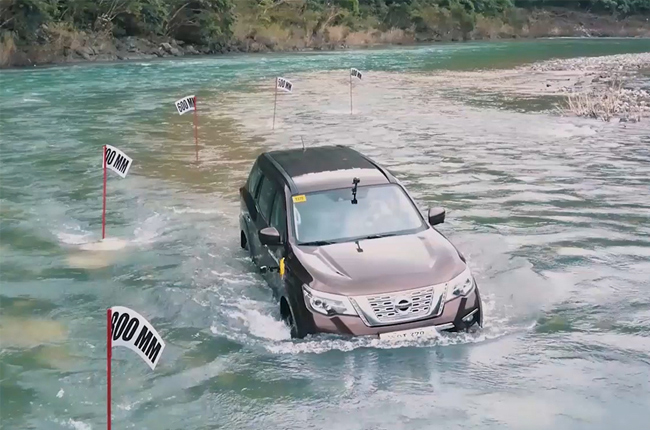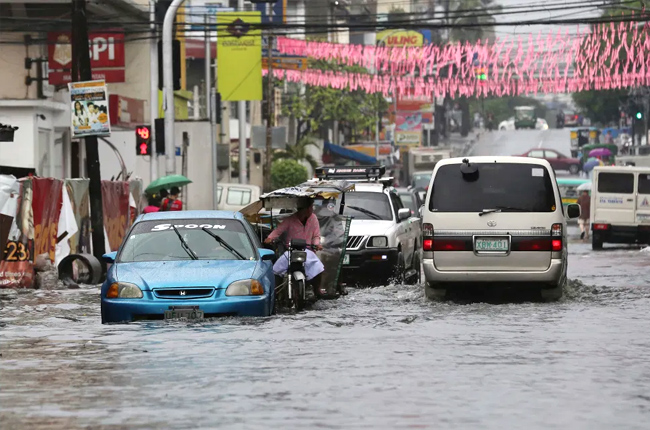
During heavy downpours, there is a high chance for flash floods to occur, especially in urban areas where the majority of water canals are not properly maintained. Given the high probability of floods in the Philippines especially during the rainy season, many buyers are considering crossovers, SUVs, and pickups with high wading depth, allowing them to cross through floods with more confidence.
While taking alternate routes does seem like a good idea, there are times that you just have no choice but to cross through the flood. Whether you have a small car or even high-riding vehicles that can cross, there are still some things you should take note of in order for you not to end up stalling your vehicle in the middle of a flood. That said, here are some ways on how you can safely drive your vehicle through a flood.
Check your vehicle’s water wading depth

High-riding vehicles like the Ford Everest, Ford Ranger, Nissan Terra, Nissan Navara, Mitsubishi Montero Sport, Mitsubishi Strada, and many others are more than capable of crossing through floods, as some of these models even have an 800 mm water wading depth. Floods are more concerning for smaller cars like sedans and hatchbacks, as these vehicles lack the ride height of those aforementioned models.
Proceed through the flood if you think your car’s wading depth can cover the amount of water, if not, then your last resort is to find an alternate route instead. You can even just stay at the corner and park until the flood subsides, otherwise, if that’s going to take long, then just cancel your plans and go home, you don’t want to risk your car from the possible urban floods.
Another tip is for you to plan ahead, if you happen to experience a heavy downpour outside of your house then it’s better not to leave unless you have the right vehicle that’s capable enough to cross through floods or a good enough reason to risk it.
Let oncoming vehicles pass through the water first

Before you proceed, check if there are oncoming vehicles. If there are, let them pass first especially if they are large vehicles or traveling fast as these vehicles could splash your vehicle.
Proceed and drive on the highest point of the road

This is one of the reasons why you should patiently wait for oncoming vehicles to pass through. During floods, most roads are deep on either side. There are some instances when it’s best for you to cross at the middle path of the road in order for your vehicle to travel through the water. Then again it still depends on the road you're on, as local highways and other wider roads have a pool during a storm, making it more ideal to settle on either corner of the road.
Watch your speed—Don’t drive too fast

5 to 6 km/h should be an ideal speed when crossing through a flood. Do not drive too fast, as you will be risking your tires from losing their grip on the road. Keep the pressure on your accelerator constant. Feather the throttle, but don’t floor it.
If your tires lose grip, don’t slam on the brakes, just gently lift your foot off the accelerator and keep your steering wheel straight until the grip returns.
Maintain proper momentum—Do not stop

Do not let your car come to a halt, as doing this could allow water to get into your car’s exhaust pipe, other mechanical components, and even your car’s interior, also, remember to keep the engine revs up. If you’re driving a manual, just be steady with the accelerator and keep a foot on the clutch pedal just in case you need to keep the engine from stalling. For automatic vehicles, select the lowest possible held gear and remember to keep your foot on the accelerator in order to maintain proper momentum.
Dry your brakes

After you’ve successfully crossed the horrendous flood, now, it’s time to dry your car’s brakes. In order to do this, first, find a safe place and then feather your car’s brakes a few times in order to ensure its responsiveness on the road. Do not slam your brakes, as you could cause a possible rear-end collision with the passenger behind you.

If you haven’t successfully gone across the water and your vehicle just stalled all of a sudden, don’t panic and just stay inside of your car and call for help. Remember, do not get out and open the hood as could worsen the damages your car has accumulated from the flood.
Latest Features
-
An all-electric future: The Porsche Macan Electric / Featured Article
Porsche’s Macan goes all-electric; it’s a new beast with an electrified heart, yet unmistakably Porsche in performance and spirit.
-
Which Kia should I buy? / Featured Article
We’re here to help you decide which Kia vehicle is best for you, whether it’s a sedan, crossover, or minivan.
-
Why Lynk & Co is a good option for luxury car buyers / Featured Article
Lynk & Co offers premium value for those exploring the luxury market.
Popular Articles
-
Electric Vehicles in the Philippines for under P1 million
Jerome Tresvalles · Aug 19, 2025
-
Top 3 Cars For Every Lifestyle—What Cars Are Right For You? | Behind a Desk
Caco Tirona · Apr 24, 2024
-
5 Tips to Maximize Fuel Efficiency
Jerome Tresvalles · Sep 09, 2024
-
Five driving habits that are draining your fuel tank
Jerome Tresvalles · Jun 24, 2025
-
Can engine braking harm your engine?
Jerome Tresvalles · Sep 11, 2025
-
Do electric cars even need maintenance?
Jerome Tresvalles · Oct 23, 2024
-
Best vehicles for an active outdoor lifestyle
Shaynah Miranda · Jul 25, 2024
-
How to drive different types of vehicle transmissions
May 23, 2024
-
5 easy ways to keep your car interior clean
Allysa Mae Zulueta · Nov 15, 2021
-
How to survive Metro Manila traffic
Earl Lee · Aug 16, 2022



